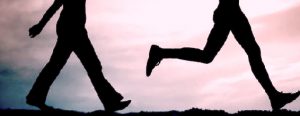Running is a great exercise that requires no training equipment and minimal arrangements. It doesn’t merely keep you fit, it makes you happier and healthier, filling up your lungs with fresh air and warming up your skin with sunlight. It is an ideal way to spend your evening or to form social ties with others who share the same interest. In order to run, you don’t need to be young or quick. It is an activity you can pick up at any time in your life and incorporate it according to your stamina and age group. In order to run, you just need a comfortable pair of running shoes and the desire to make the run, slow or fast, depending upon your body requirements. So are you ready to hit the road? Get set and go!
Running Form

Before you tread on your road to fitness, you need to understand your running form. Some people naturally place their foot on the ground in a manner that their heels strike the ground, while other put their toes down first. Since both forms are acceptable when it comes to running, it is very important for you to follow your inherent style to avoid risk of injury. Once you start running, you will get used to your natural stride making you comfortable in your form and helping you get fit.
Alternate Running And Walking

An easy way to become accustomed to running is to incorporate a run-walk method to avoid tiredness and stress. Designed by famous Olympian Jeff Galloway, the method isn’t meant to take breaks when the runner is tired. Instead the athlete should shift from running to walking when he is at the climax of running. Depending upon your body’s stamina, you can choose a customized run-walk ratio. However, refer to the following general plan for guidance.
| Level | Run | Walk | Repeat |
| Beginners | 30 second | 2 minutes | For the entire duration of the run |
| Intermediate | 3-5 minutes | 2 minutes | For the entire duration of the run |
| Expert | 6-10 minutes | 1 minute | For the entire duration of the run |
The walking breaks after short intervals of run help muscles recover from any injury that occurs during the activity. It is useful for beginners as well as Olympian trainers alike as quick recovery helps in longer runs with healthier outcomes.
Devise A Training Program

Like all other workouts, you need to devise a training program for running as well so that you can achieve maximum results from this healthy activity. Running comes with the advantage of being extremely flexible that it can be incorporated into any type of routine. However, its benefits can still be manifold if you dedicate some time specifically to this simple activity. It’s best to devise a plan that’s simple. Here is a basic formula which you can alter depending upon your goals and preferences.
- Run for 3 days a week.
- Run or run/walk for 30 minutes, 2 days a week.
- Run or run/walk for 1 hour on Sunday.
- Engage into different trainings or rest on off days.
- Run at a speed that it is possible for you to hold conversation with other runners.
- Take regular walk breaks during your running to help your muscles repair and recover.
Beginners start off with a 3.1 mile race that is easier for them to finish than longer races. To make it more interesting, you can invite your friends and neighbours to join you in this healthy activity. Make it motivating by holding small competitions. Once you are comfortable with your pace, you can slowly notch up, increasing your speed and distance.
Surface Matters

Beginners often ponder about the kind of surface they should choose to run on. There is no one right answer for this question. Like with many other workouts, to get most out of your running, you should choose incorporate different types of surfaces into your workout.
- Pavement: This type of surface is ideal for experienced runners. Pavements reduce the risk of turning ankles, however, the flat surface is very hard on the joints, as it does not support the natural curve of the foot. Therefore, it’s best for light runners with a good body posture to run on this surface.
- Forest Or Leafy Surface: This type of surface is ideal for running as it helps provide the foot with the needed support. But, there is a high risk of falls and injuries as there are many rocks, roots and other hurdles.
- Sandy Surface: Sandy surfaces target leg muscles as they need to work hard to maintain balance on an uneven surface. These surfaces make running easy as they lift the feet. Considering the unevenness of these surfaces, you can easily stress your calf muscles.
- Tartan: Although a synthetic track is bouncy, it adds pressure to Achilles tendon, therefore overrunning is not advisable.
- Treadmill: A treadmill provides suitable support to the foot. However, you need to pay special attention to your form as the belt beneath your feet is constantly moving.





